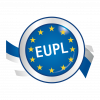The French law free software licence CeCILL 2.1 is published, ready for being OSI approved and it is compatible with the EUPL.
The French administration intends to reinforce distribution of its own software developments as Free Software (“Logiciel Libre”). For this purpose, the French Prime Minister instructions on the usage of Free Software in the French administration (known as the "Ayrault Memorandum" or “circulaire Ayrault” in French) presented guidelines and recommendations on the proper use of Free Software in the French administration.
The Ayrault Memorandum remains that several major types of licenses have been defined, including one in French law, the Free Software Licence CECILL (proposed by three major research and software production centres: CEA CNRS and INRIA)
The new version 2.1 of CeCILL has been submitted to the certification of the “Open Source Initiative (OSI). The text of this new version is now OSI-approved and published on the CeCILL site
One of the most interesting modifications (from the EUPL community point of view) is that CeCILL 2.1 introduces compatibility with the European Union Public license (EUPL)
The new article 5.3.4 of CeCILL states:
The Licensee can include the modified or unmodified Software in a code that is subject to the provisions of one of the versions of the GNU GPL,and/or GNU Affero GPL and/or EUPL, and distribute that entire code under the terms of the same version of the GNU GPL,and/or GNU Affero GPL and/or EUPL.
Such interoperability is especially welcome. It will be authorised to reuse (i.e. copy and paste) any needed piece of code between a project covered by CeCILL and a project covered by the EUPL.
Concretely, it means that the developers of projects licensed under the EUPL may incorporate in their project any software code, files or components distributed under CeCILL 2.1. In a reciprocal way, the developers of projects licensed under CeCILL may incorporate in their project any software code, files or components distributed under the EUPL.
The enlargement of a “circle of trust” between licences sharing the aim of avoiding exclusive appropriation of covered software code by third parties looks very positive: without being “viral” or self centric, this good practice multiplies developer’s freedom for combining software components and keeping the distribution of the modified project under their usual licence provide it is “from the trusted list”.
Such enlargement is not “European centric”. Recently, an important State of Canada asked for reusing one of the linguistic versions of the EUPL, changing the licensor name (references to the EU) and jurisdiction, but keeping all other provisions, including the list of compatible licences. This will authorise developers working under the EUPL (or under the CeCILL, or under other licences listed as compatible) to benefit from software code developed under the new Canadian copyleft licence.
Comments and Questions:
- Is such a need for reusing files, software code or components very frequent?
Yes, assembling files or pieces of code is the current way of programming. Developing specific compatible open source modules for electronic signature, procurement, data encryption, search engines, content management etc. increases productivity and harmonizes technical solutions. In this framework, a legal interoperability between software or content licences is an advantage.
- Does licence compatibility increase the risk of legal forking (project being “relicensed under another licence”)?
Based on experience, it is not the case. For example, it was never observed in five years EUPL distribution. Relicensing a project covered for example, by the CeCILL or by the EUPL is never authorised: a successful project is the combination of multiple elements: a charismatic or prestigious licensor (i.e. the French government, the European Parliament, the Commission), well written code, a brand name, an efficient communication policy (DNS, Web site design and style, logo, promotional events etc.) and – probably the most important: an active and dynamic supporting developer’s and user’s community, driven by good and motivated persons. The licence covers “only” the second element (by order of importance, after the supporting community): the software code. Therefore licence interoperability allows you to benefit from all or part of this code in your own project, but does not facilitate taking-over or forking the original project.
- However, forking occurs sometimes?
Yes it occurs sometimes, but for other reasons than reusing code: it may be that the original licensor decides to change its licensing policy (and not all licensees agree) or that a significant part of the community don’t trust the original licensor anymore and want to restart a new project on new licensing basis, new leadership and to rebrand the whole solution. In all other cases the reuse of code will stay marginal (i.e. limited to the needed files, APIs or data structures) or will not impact the project distributed under its primary licence. For example, it would be possible that the parliament of the Republic of India will starts a project from a tool primarily developed by the European Parliament, because the EP will not make the effort to localize its own tool in Standard Hindi language, Dravidian or other languages spoken in the Indian peninsula.
For More information:
The CeCILL site: http://www.cecill.info/licences/Licence_CeCILL_V2.1-en.html
OSI Licence review: http://projects.opensource.org/pipermail/license-review/2013-March/000539.html.
Anyone (once freely registered as Joinup user and logged in) may publish comments on the above

